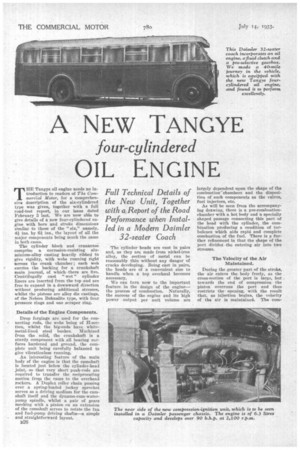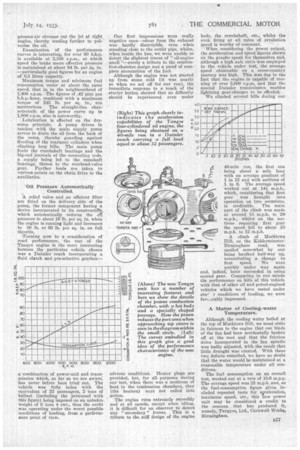A NEW TANGYE
Page 40

Page 41

If you've noticed an error in this article please click here to report it so we can fix it.
four-cylindered
OIL ENGINE
Full Technical Details of the New Unit, Together with aReport of the Road Performance when Installed in a Modern Daimler 32-seater Coach
THE Tangye on engine needs no introduction to readers of The Commercial Motor, for a comprehensive description of the six-cylindered type was given, together with a full road-test report, in our issue dated February 3 last. We are now able to give details of a new four-cylindered engine with bore and stroke dimensions similar to those of the "six" namely, 41 ins. by 6-1 ins., the layout of all the major components being much the same in both cases.
The cylinder block and crankcase comprise a corrosion-resisting atu.miniim-alloy casting heavily ribbed to give rigidity, with webs running right cross the crank chamber ; each web carries the backing for a crankshaft main journal, of which • there are five. Centrifugally cast " wet " cylinder liners are inserted from the top and are free to expand in a downward direction without producing additional stresses, whilst the pistons are alloy die castings, of the Nelson Bohnalite type, with four pressure rings and one scraper ring. "
Details of the Engine Components.
Drop forgings are used for the connecting rods, the webs being of H-seetion, whilst the big-ends have whitemetal-lined steel hushes. Machined from the solid, the crankshaft is a sturdy component with all bearing surfaces hardened and ground, the complete unit being carefully balanced to give vibrationleas running.
An interesting feature of the main body of the engine is that the camshaft is Located just below the cylinder-head joint, so that very short rush-rods are required to transfer the reciprocating motion from the cams to the overhead rockers. A Duplex roller chain passing over a spring-loaded jockey sprocket serves as a driving medium for the camshaft itself and the dynamo-cum-waterpump spindle, whilst a pair of gears meshing with a pinion. on an extension of the camshaft serves to rotate the fan and fuel-pump driving shafts—a simple and straightforward layout.
l32G The 'cylinder heads are at in pairs and, as they are made from nickel-iron alloy, the section of metal can be reasonably thin without any danger of cracks developing. Being cast in pairs, the heads are of a convenient size to handle when a top overhaul becomes necessary.
We can turn now to the important feature in the design of the engine— the process of combustion. Naturally, the success of the engine and its high power output per unit volume are
largely dependent upon the shape of the combustion--charnbers and the disposition of such components as the valves, fuel injectors, etc.
As will be seen from the accompanying drawing, there is a pre-combustionchamber with a hot body and a specially shaped passage connecting this part of the head with the cylinder, the combination producing a condition of turbulence which aids rapid and complete combustion of the fuel. There is a further refinement in that the shape 'of the port divides the entering air into two streams.
The Velocity of the Air Maintained.
During the greater part of the stroke, the air, enters the body freely, as the cross-section of the port is large, but towards the end of compression the piston overruns the port and thus restricts the opening, with the result that, as injection begins, the velocity of the air is maintained. The coot pressed-air streams cut the jet at right angles, thereby tending further to pulverize the oil.
Examination of the performance curves is interesting, for over 90 b.h.p. is available at 2,100 r.p.m,, at which speed the brake mean effective pressure is maintained at about 94 lb. per sq. in. —particularly good figures for an engine of 6.3 litres capacity.
Maximum torque and minimum fuel consumption occur at about the same speed, that is, in the neighbourhood of 1,400 r.p.m. The figures of .42 pint per b.h.p.-hour, combined with a maximum torque of 245 lb. per sq. in., are meritorious. The straight-line characteristic of the power curve up to 1,800 r.p.rn. also is noteworthy. Lubrication is effected on the drysump principle. A pump driven in tandem with the main supply pump serves to drain the oil from the hack of the sump, thereby guarding against flooding of the rearmost cylinders when climbing long hills. The main pump feeds the crankzhaft bearings and the big-end journals of the connecting rods, a supply being led to the camshaft bearings, thence to the overhead-valve gear. Further leads are taken to various points on the chain drive to the 'Oil Pressure Automatically Controlled.
'A relief valve and an efficient filter are fitted on the delivery side of the pump, the former component having a device incorporated in its constructin. which automatically reduces the
pressure to about 10 lb. per sq. in. when the engine is running light and increases to 50 lb. or 60 lb. per sq. in. on full throttle. Turning now to a consideration of road performance, the test of the Tangye engine is the more interesting because the particular vehicle chosen was a Daimler coach incorporating a fluid clutch and pre-selective gearbox
600 800 1000 1200 1400 R.. P. M.
a combination of power-unit and transmission which, so far as we are aware, has never before been tried out. The vehicle was fully laden with the equivalent of 32 passengers, 2 tons of ballast (including the personnel with this figure) being imposed on an unladen Weight of 6 tons 4 cwt., thus the outfit _was operating under the worst possible conditions of loading, from a performance point of view.
1600 1800. 2000
• Our first impressions were really negative ones—odour from the exhaust was hardly discernible, even when standing close to the outlet pipe, whilst, when inside the bus, we were unable to detect the slightest traces of " oil-engine smell "—surely a tribute to the combustion-chamber design and a proof of complete atomization of the fuel. Although the engine was not started up from stone cold (it was nearly so when we set off for our run), the immediate response to a touch of the starter button showed that no difficulty should be experienced even under adverse conditiong. Heater plugs are provided, but, for all purposes during our test, when there was a modicum of heat in the combustion chambers, they (the heaters) were not called into action. The engine runs extremely smoothly and at all speeds, except when idling, it is difficult for an observer to detect any " secondary " forces. This is a tribute to the stiff design of the engine body, the crankshaft, etc., whilst the even firing at all rates of revolution speed is worthy of comment.
When considering the power output, the acceleration and speed figures shown on the graphs speak for themselves and, although a high axle ratio was employed in the vehicle under test, the average speed obtainable on a cross-country journey was high. This was due to the fact that the engine is capable 'of running at over 2,000 r.p.m. and that the special Daimler transmission enables lightning gear-changes to be effected.
We climbed several hills during our
40-mile run, the first one being about a mile long with an average gradient of 1 in 12 and with sections of 1 in 9. The average speed worked out at 14i m.p.h., which, considering that first gear was brought into operation on two occasions, is creditable. The main part of the climb was made at around 15 m.p.h. to 2() m.p.h., whilst on the sections requiring first gear the speed fell to about 10 m.p.h. to 12 m.p.h. A climb of Mucklows Hill, on the KidderminsterBirmingham road, was spoiled somewhat by our being baulked half-way up, necessitating a change to first speed. We were quickly under way again and, indeed, later succeeded in using second gear. Comparing in our minds the performance on hills of this vehicle with that of other oil and petrol-engined vehicles which we have tested under aim r conditions of loading, we were favt.urably impressed.
A Matter of Cooling-water Temperature.
Although the cooling water boiled at the top of Mucklows Hill, we must state in fairness to the engine that one blade of the fan had been accidentally broken off at the root and that the friction drive incorporated in the fan spindle was badly adjusted, with the result that little draught was created. With these two defects remedied, we have no doubt that the water would he maintained at a reasonable temperature under all conditions. The fuel consumption on an overall test, worked out at a rate of 10.6 m.p.g. The average speed was 23 m.p.h. and, as the fuel-consumption figure given in-. eluded repeated tests for areleration, maximum speed, etc., this new power unit may be considered a credit to the concern that has produced it, namely, Tangyes, Ltd., Cornwall Works, Birmingham.




























































































